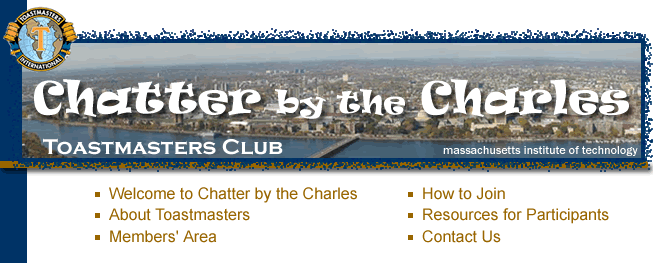![]()
| Meeting Roles | Officer Roles | Mentoring |
Meeting Role Descriptions
- Toastmaster
- Timer
- Grammarian
- Ah Counter
- Speaker
- Table Topics Master
- General Evaluator
- Speech Evaluator
Purpose:
The main duty of the Toastmaster is to act as the genial host who conducts
the day's program. As Toastmaster, you set the tone of the meeting and
ensure that it runs smoothly. Think about ways you could make your meeting
unique.
Preparation:
At the end of the previous meeting, confirm
the next week's meeting roles with the VP of Education. If there are gaps
in the agenda, discuss how they will get filled. If you would like to
change the standard meeting in any way (for instance, by adding a new
role, changing the order of events, or using a theme), work with the VP
of Education to create a suitable agenda for the meeting.
Over the course of the week, get in touch with all
Speakers, the Table Topics Master, and the General Evaluator to ensure
that they are prepared, and to gather the information you will need for
their introductions. In addition, if you are trying a special meeting
format, be sure to let them know about it in advance. The earlier you
contact these key people, the better, as it gets everyone thinking and
preparing ahead. If you learn that anyone assigned
to a role is unable to fill it, have them contact the VP of Education
as soon as possible and encourage them to find a replacement.
Prepare and practice introductions for Speakers, the Table Topics Master,
and the General Evaluator. Introductions should be lively, colorful, and
complimentary, and should prepare the audience to listen with excitement
and attention. The Toastmaster is entitled to use a little artistic license
to make this happen. Speaker introductions are particularly important,
and should include the goals of the speech as well as information about
the speaker and topic. Introductions for the Table Topics Master and General
Evaluator need not be so elaborate, but should include more than just
the person's name.
Finally, prepare some opening and closing remarks, and think about how
you plan to bridge the gaps between program segments.
As you Arrive at the Meeting:
Arrive at the meeting by 12:15 p.m., reserve
a seat for yourself near the lectern, and help greet members and guests.
Confirm that all meeting participants are present. Make any last-minute
changes that are necessary.
During the Meeting: Make brief introductory remarks and explain the purpose of the meeting.
Introduce each of the functionaries (Timer, Ah Counter, and Grammarian),
and lead the applause after each has explained his or her role
(and the Grammarian has provided the word of the day). Try to incorporate
the word of the day at least once during the meeting.
If there are guests present, invite them to stand and briefly introduce
themselves, leading the applause when they are finished. Let them know
that we are glad they came.
Introduce each speaker. Lead the applause until the speaker reaches
the lectern, then shake hands. Once the speaker has acknowledged you and
assumed control of the meeting, be seated. At the end of each speech,
lead the applause again, shake hands, and offer a brief word of appreciation.
Then transition to the next speaker.
After the last prepared speech, introduce the Table Topics Master and
indicate how much time he or she has for the segment. (Table topics should
generally wrap up at around 1:10.) Again, lead the applause before and
after the segment, and shake hands with the Table Topics Master to exchange
control of the lectern.
Thank the Table Topics Master and make a transition to the next section.
Give your prepared introduction for the General Evaluator, who will then
handle the evaluation portion of the agenda. When the General Evaluator
has turned the meeting back over to you, make your closing remarks and
return control of the meeting back to the President.
After being introduced by the President, move to the lectern and shake
the President's hand. Now you are in charge of the meeting. Preside with
confidence, and make the audience feel welcome.
Helpful Links:
District
52's Toastmaster role sheet includes Toastmaster checklist and speaker
intro guidelines (PDF)
Platform
Control by Joe De Rico, ATM
Preparing
an Intro from Parliament Hill Toastmasters
The
Importance of Introductions from Addison Singles Toastmasters
